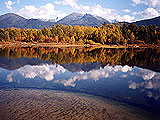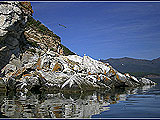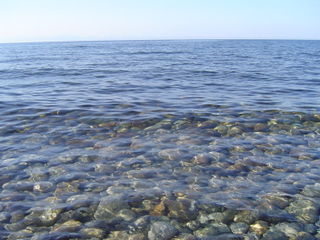Articles about maps
History of cartography
All about topographic maps
Topographic maps and traveling
Two centuries of Russian Cartography
Navigation software and offline maps
Topographic maps and traveling
Altai region
Bicycle touring routes and topographic maps
Bicycle tourism in Crimea
Bycling touring and topographic maps
Carpathian mountains
Caucasus Mountains
East Sayan Mountains
Kamchatka region
Lake Baikal
Olkhon - the heart of Baikal
Plateau Putorana
Rafting and topographic maps
Rafting directions and topographic maps. Part 1
Rafting directions and topographic maps. Part 2
Topography of China
Lake Baikal

Baikal is one of the biggest lakes in the world, the largest freshwater lake in Russia. Its length is about 636 km, the square of water surface is 31500 of square km. Baikal is 1,7 times bigger than Ladoga Lake, which is the biggest lake in Europe. Among freshwater lakes it occupies the 6th place. Bigger than it are two African lakes – Victoria and Tanganyika lakes, and three from five Great Lakes of America – Superior, Michigan and Huron.
Geographical description of Lake Baikal
Lake Baikal and its catchment’s basin belong to unique geosystem of the world. Baikal is situated in the central part of Eastern Siberia, not far away from relative centre of Asia. Mountain basin of the lake is a very important natural frontier of Siberia. Borders of various flora and fauna areas are contiguous in this region, thus creating ecosystem, which doesn’t have analogues.
Baikal is one of the greatest lakes on the planet: it is the deepest lake in the world (1637 m ), the most ancient (about 25 millions years ago), contain the largest number of endemics (more than 1000) and flora and fauna representatives (more than 1600), living in sweet basins of the world. The lake has a unique volume (23 600 of cube kilometers) and supply of sweet water (20 %). Baikal hollow is the central element of reef zone, which appeared and developed together with world reef system. A number of factors allow to suppose that the lake is incipient ocean. Unusually mild for Siberia the climate of Baikal shore, the number of solar days is more than in many others Black Sea coasts. 336 rivers fall into Baikal (Selenga, Barguzin, Upper Angara, etc.) and only river Angara flows out of Baikal.
The whole lake (the total square of columbine 557 thousands of square kilometers, from it 332 km in Russia) appears to be peculiar and rather delicate natural geosystem, the base of which is the system of the lake with its natural process of first drinkable water forming.
Geologic peculiarities of Lake Baikal structure

The most outstanding peculiarity of Baikal is its antiquity. Taking into account deep relict endemism of lake fauna, a lot of scientists determine its age 20-30 millions of years. The majority of lakes, especially of glacial and of ancient origin, live 10-15 millions of years and then fill with sediments, cover with quagmires and sooner or later turn into marshes and then dry up. Last researches allowed geophysicists to offer a hypothesis, that Lake Baikal is on the contrary an incipient ocean. It proves to be true by the fact that banks disperse with the speed of 2 cm per year just as Africa and South America, coasts of Mediterranean and Red sea disperse. Together with active moving of the earth's crust, in Baikal region considerable magnetic anomalies along its axis have been marked. These anomalies can be compared with similar anomalies in middle-atlantic break. The lake has lot characteristics that are typical for an ocean: ocean deeps, a large amount of water, inside waves and seiches, flows, storms, high waves, pan expansion due to bank separation, also high amount of magnetic anomalies, etc.
The lake lies in Baikal hollow – bottomless stone bowl, all around surrounded by mountains. The hollow is framed by middle high Primorsky and Baikal ranges in western part, Barguzinsky (with maximal height 2840 m) and Khamar-Daban ranges in southern and south-eastern part. The depth of the hollow is determined by the height of the mountains above it, the depth of the lake and the thickness of covering its bottom friable sediments. The layer of thee lake sediments sometimes obtains 6000 m, and its size two times exceeds the size of the lake and obtain 46 000 of cube kilometers. It’s easy to calculate that the depth of Baikal crystal lodge achieves 8-9 kilometers.
The deepest place of Baikal lies at 7000 meters below ocean level. Baikal hollow is the deepest pan on the Earth. Its “roots” cut the whole earth crust and go in the upper mantel at the depth of 50-60 kilometers.
Hydrology of Lake Baikal

Annually in Baikal 60 cube kilometers of gorgeous and unique by quality water is reproduced in Baikal. Its water can be sometimes used as distilled water. Uncommon water cleanness is provided by vital functions of its unique vegetative and animal world. Among the main characteristics of Baikal water we can distinguish: small amount of dissolving and suspended mineral matters, insignificant amount of organic mixtures, and a lot of oxygen. Average mineralization of Baikal water is 120 mg per liter, while in other lake is can achieve 400 mg and even more per liter. Total content of ions in Baikal water is 96 mg per liter.
The clearness of water depends on its cleanness. Baikal is not only highly clean lake, but also the clearest lake in the world. In spring, when the ice has melt the clearness of the water is 40 meters – in ten times more than in other lakes. Sargasso Sea is considered to be a model of the clearest water in the world that is practically similar to the clearness of distilled water. Here Seki disc disappears at the depth of 65 meters. The latest researches show that at the depths of 250-1200 meters the clearness of Baikal water is the same as in Sargasso Sea.
Climatic characteristics
According to the hours number of sun shining Baikal is richer than other territories of Siberia and even some western and southern parts of the country.
The temperature of the water in the surface layer changes from +14, +15 С (in August) to 0 C (in December-January). In coastal regions the temperature can achieve +16, +17 C, mostly in eastern part. In shallow bays and shores the temperature can rise up to +22, +23 C. In general Baikal begins to freeze on 21st of December and melt on 16th of January.
Animal and plant world
The oneness of many Baikal characteristics is the reason for its unusual variety of vegetative and animal world. And in this factor Lake Baikal has no equal among all freshwater reservoirs. In Lake Baikal lives the half of all sorts of freshwater mollusks, also a half of all sorts of oligochaetes, etc. And more than (2630) kinds and sorts (1550) of animals and plants (1805), found at the present time in the lake, practically 75 % of them are endemic, which means that they appeared in this lake and do not live anywhere else.
River Angara
Angara – “daughter of Baikal” – is the only river that flows from Baikal. Its length is 1860 km. Annually Angara carries out from Baikal 61 cube km of water, and all its tributaries carry with 59 cube km. Angara springhead is situated at the level of Baikal, that is at the height of 476 above sea level and mouth – at the height of 76 m. The drop is 380 m and is used by hydroelectric power station cascade, built in Angara. The width of the river in the springhead is 1 km, the depth varies from 0,5-6 m, the flow velocity in fairway is 1-2 meters per second.
Baikal map set is available for purchasing.



